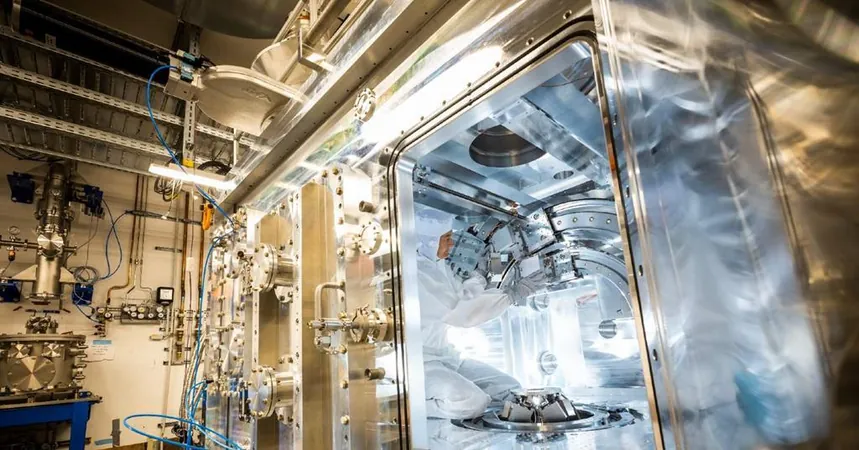
Groundbreaking Revelation: Scientists Successfully Characterize Liquid Carbon for the First Time!
2025-06-02
Author: Emma
A Historic Breakthrough in Carbon Science
In an extraordinary scientific milestone, researchers have unraveled the mysteries of liquid carbon using an ultra-powerful laser—marking the first time this elusive state has been characterized in a lab setting. This innovative work sheds light on a fundamental building block of our universe that has long confounded scientists.
The Challenges of Liquid Carbon Formation
Liquid carbon is notoriously challenging to produce due to its tendency to evaporate at normal pressures and the extreme conditions—hundreds of atmospheres of pressure—required for its existence. Dominik Kraus, the physicist leading the study at the University of Rostock in Germany, shared, "Carbon has the highest melting temperature of all materials under these conditions, making laboratory analysis nearly impossible."
A Glimpse Beyond the Surface
Craig Schwartz, a materials characterization expert at the University of Nevada, Las Vegas, elaborated on the difficulties, stating that scientists face a race against time to analyze the sample before it disintegrates. Until now, our understanding of liquid carbon’s structure and dynamics has remained largely unexplored. Schwartz lamented, "We essentially know very little about it."
The Importance of Understanding Liquid Carbon
Grasping the behavior of liquid carbon could open doors to advanced technologies vital for modern processes, including the development of novel carbon materials and nuclear fusion reactors. Richard Saykally, a physical chemist at UC Berkeley, discussed the broader implications, saying, "Liquid carbon is a crucial intermediate in nearly all advanced carbon forms, from nanodiamonds to potentially novel nanotubes."
Liquid Carbon's Role in Planetary Sciences
Beyond lab applications, liquid carbon is thought to exist deep within the interiors of planets like Uranus and Neptune. Kraus suggested that studying it could help scientists model carbon's behavior in these extreme environments, with potential impacts on planetary heat flow and magnetic fields.
Innovative Techniques to Create Liquid Carbon
To create liquid carbon successfully, Kraus and his team utilized a cutting-edge solid-state laser from the UK’s European XFEL facility, employing shock compression waves to achieve pressures over one million atmospheres. These waves, simultaneously heating the material to about 7000K, allowed the formation of liquid carbon for brief moments, measured in nanoseconds.
Remarkable Data Unveiled
The team captured unprecedented snapshots of liquid carbon's structure using ultrabright x-ray pulses, each lasting just 25 femtoseconds. Saykally remarked that these findings are the most detailed ever obtained, with data aligning closely with theoretical expectations.
Unraveling the Characteristics of Liquid Carbon
Intriguingly, even in its liquid state, carbon atoms maintain a tendency to stay close to four neighboring atoms, partially preserving the tetrahedral structure seen in solid diamond. Kraus noted they also constrained the melting temperature to about 6700K at a pressure of 1.2 million atmospheres.
Looking Ahead: Future Research Directions
As a next step, Saykally emphasized the need to examine the electromagnetic properties of liquid carbon, while Kraus's team plans to expand their techniques to explore other materials under extreme conditions—potentially unlocking new insights into planetary science and nanotechnology.









 Brasil (PT)
Brasil (PT)
 Canada (EN)
Canada (EN)
 Chile (ES)
Chile (ES)
 Česko (CS)
Česko (CS)
 대한민국 (KO)
대한민국 (KO)
 España (ES)
España (ES)
 France (FR)
France (FR)
 Hong Kong (EN)
Hong Kong (EN)
 Italia (IT)
Italia (IT)
 日本 (JA)
日本 (JA)
 Magyarország (HU)
Magyarország (HU)
 Norge (NO)
Norge (NO)
 Polska (PL)
Polska (PL)
 Schweiz (DE)
Schweiz (DE)
 Singapore (EN)
Singapore (EN)
 Sverige (SV)
Sverige (SV)
 Suomi (FI)
Suomi (FI)
 Türkiye (TR)
Türkiye (TR)
 الإمارات العربية المتحدة (AR)
الإمارات العربية المتحدة (AR)